All these mussels make good bait, but this feature concentrates on the two most frequent types, the Common mussel and the Horse mussel.
IDENTIFICATION - COMMON MUSSEL
Instantly recognized by most people. The shell is round and sharp edged at the base, it has a hump back and slightly dished front where it attaches it'self to the rock face, and the top is more pointed and blunt.
The shell is black or slightly blue in adults, but can be light brown in the smaller seed mussel. It rarely exceeds 4" in length unlike the Horse mussel which although having a similar shape grows larger to 6".
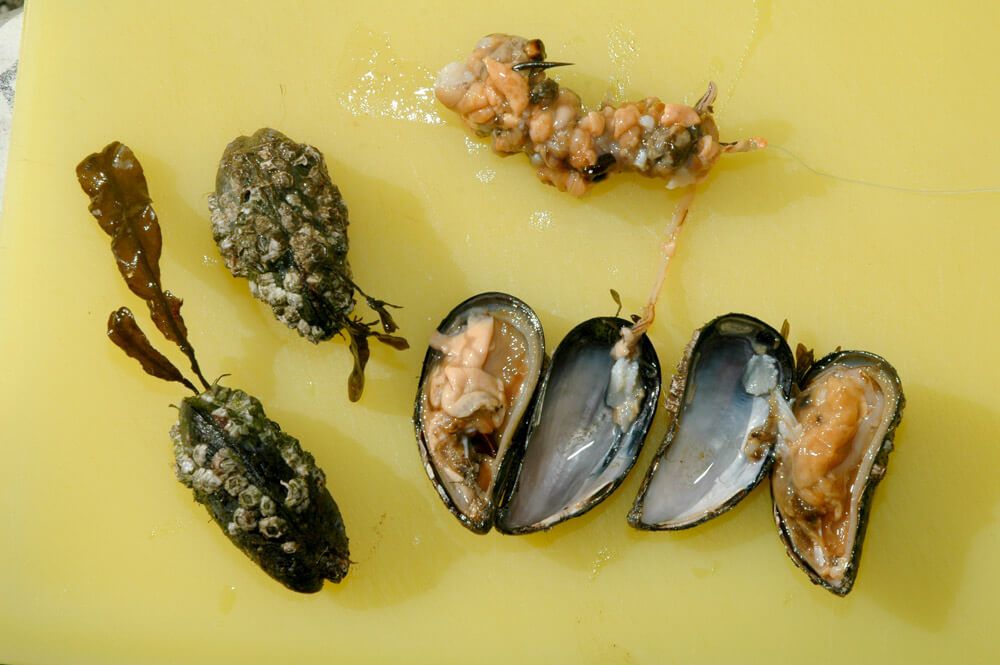
HABITAT
A group living shellfish found clustered together along the mid and lower shore in rock pools, on rocks, pier supports and jetty legs, buoys, harbour walls and along breakwaters and groynes. Very common inside estuaries on the rocks and amongst weed beds.
The Horse mussel lives in large beds just beyond the low water line over clean sand/mud, on flat rocky beds and shallow reefs.
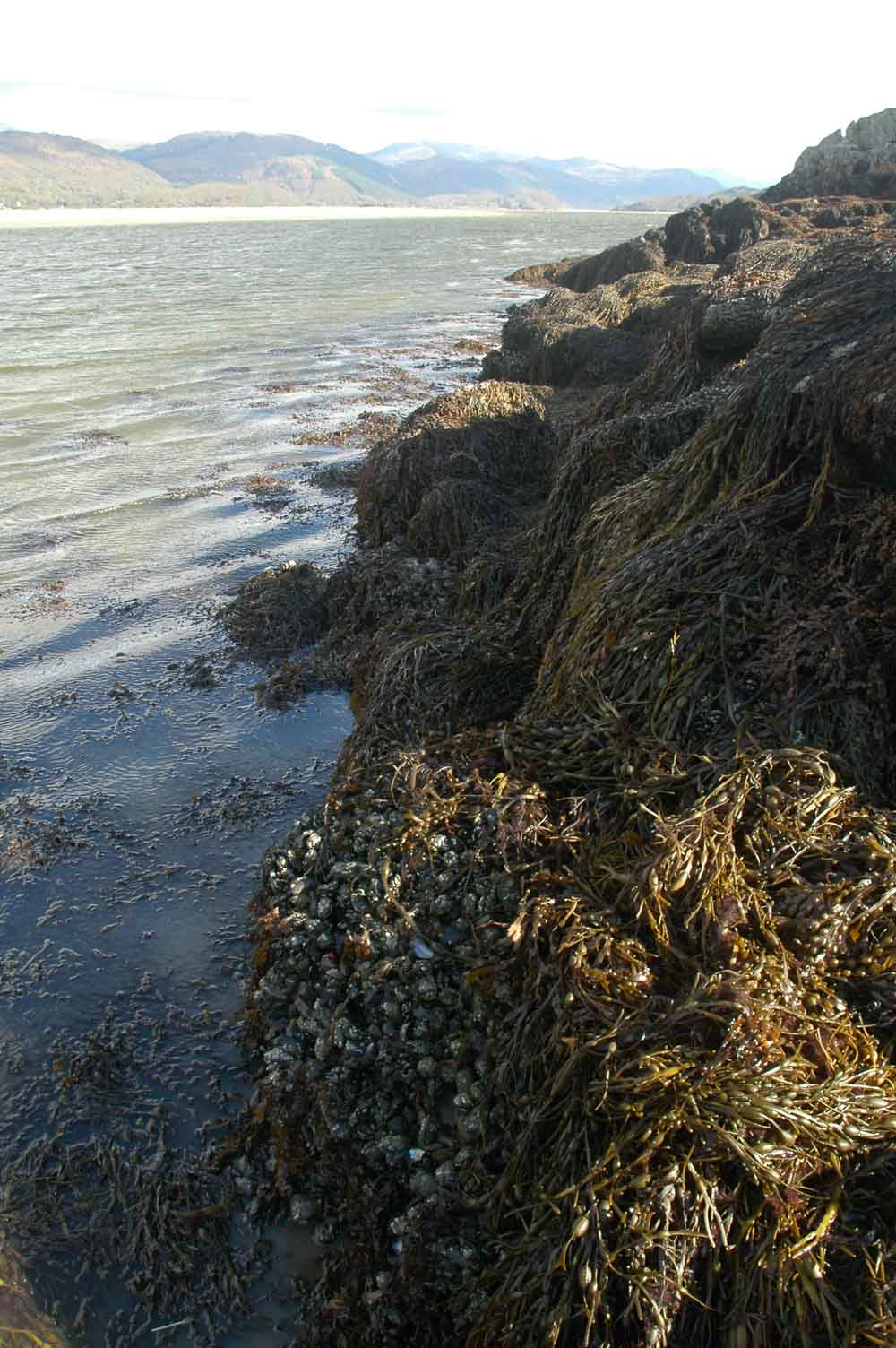
COLLECTION
The Common mussel holds itself onto the rocks and leg supports by attaching itself via a chemical thread it manufacturers through a gland in the foot. Grip the mussel across the back and just twist the hand around in a clockwise direction to release the mussels grip. Enough for a few hours fishing can be collected in just a few minutes.
Try to spread your areas of collection from one trip to the next. Don't keep taking mussels from the same pier supports and rocks otherwise you'll quickly deplete the stocks. Alternatively, choose only the single bigger mussels leaving the smaller ones to grow for future trips.
The only way to collect the larger Horse mussels is to wait until a storm tears the inshore seabed up and displaces the mussels which then litter the low tide line as they wash inshore. Again, you'll fill a bucket quickly.
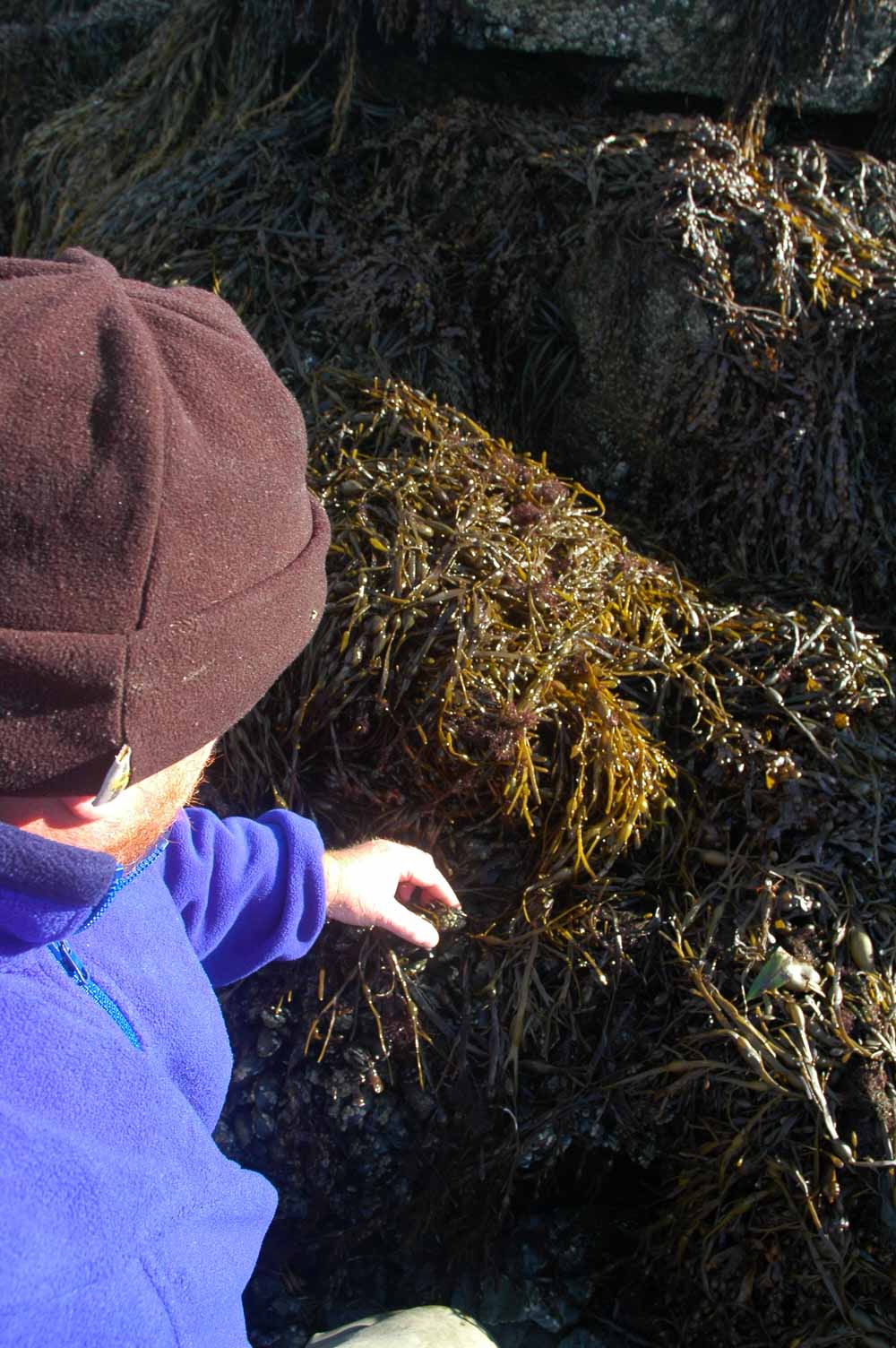
TIDES
The Common mussel is accessible even on the smallest neap tides, though jetty supports, breakwaters and the rock pools may only uncover on the bigger tides. Occasionally, the Horse mussel beds may also expose but only on the largest spring tides.
STORAGE
If you want to keep mussels alive, it's easy and simple. Wash them thoroughly of all mud, etc, as this can quickly foul the water you keep them in. Place them in a large bucket full of fresh seawater and leave them covered over with a sack. Like this they will live for at least a week in cool weather, less in the summer. It pays to change the water, if possible, every couple of days and remove any that show signs of the shell opening as these are dying.
The day before a proposed trip, shell the mussels you are likely to need and place the mussels into a plastic jar or tub with a sealable lid and leave them in the fridge. Having stewed in their own juices for 24 hours they prove far more effective than even freshly shelled mussel. It also saves fishing time rather than shelling the mussels on the beach.
You can also freeze mussels very successfully. Shell them, place them either separately or in threes and fours into cling film or small sealable envelopes, and leave them in the fast freeze compartment of the freezer until frozen and store until needed. Prepared like this means that you can accurately gauge how many packets you'll need for a trip and being in threes and fours they are bait sized and also thaw quickly for instant baiting up.
Some Northeast anglers prefer their bait mussel to be high and long past freshness. They use an unusual method to get them just right. Having shelled the mussel they place them in muslin bags or even inside a pair of ladies tights, hang them on the washing line and leave them exposed to the air for a couple of days. This both toughens them and obviously increases their smell.
If you live very close to the sea or estuary, then providing you can find a suitable place where few people go, you can collect your mussels and place them in a anchored metal mesh box and leave them just below the low water line. Obviously, they'll live indefinitely like this and are quickly available to you.
HOW TO SHELL MUSSEL
Find an old metal teaspoon from the kitchen and slight sharpen the handle end and also the leading edge of the spoon it'self. Hold the closed mussel with the flat front side towards you. Push the end of the handle into the slightly open part of the shell where the threads are that hold the mussel to the rocks. Now twist this sideways and the shell will give and open halfway. Cut the white muscle and sinew free from the shells top and bottom and the shall now fully opens. Use the sharpened spoon to scoop out the complete mussel.
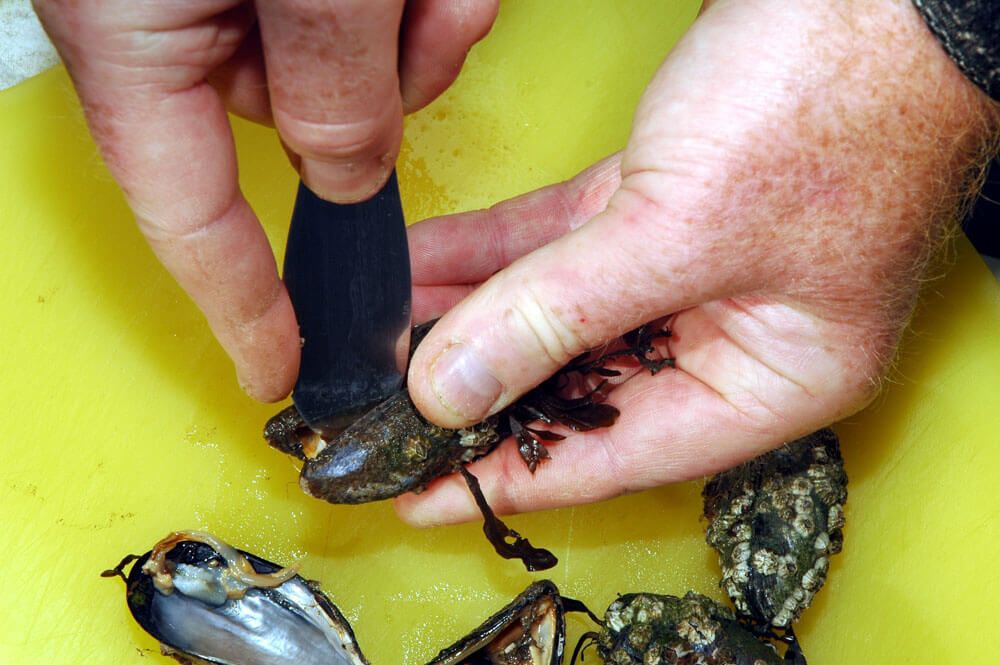
PRESENTATION
For short range fishing there is no need to use elastic to bind the mussel flesh to the hook. Put the hook point through the hard muscle end and the tongue, then pass the hook point through the mussel two or three times more to secure it. A single mussel is a good bait for plaice, flounder, coalfish, dabs, bass and small codling.
For longer range casts and also when after codling and cod over rough ground, use at least three or four mussels on a size 4/0 hook and then bind them securely with elastic thread aiming to create a sausage shaped bait with the hook point well clear.
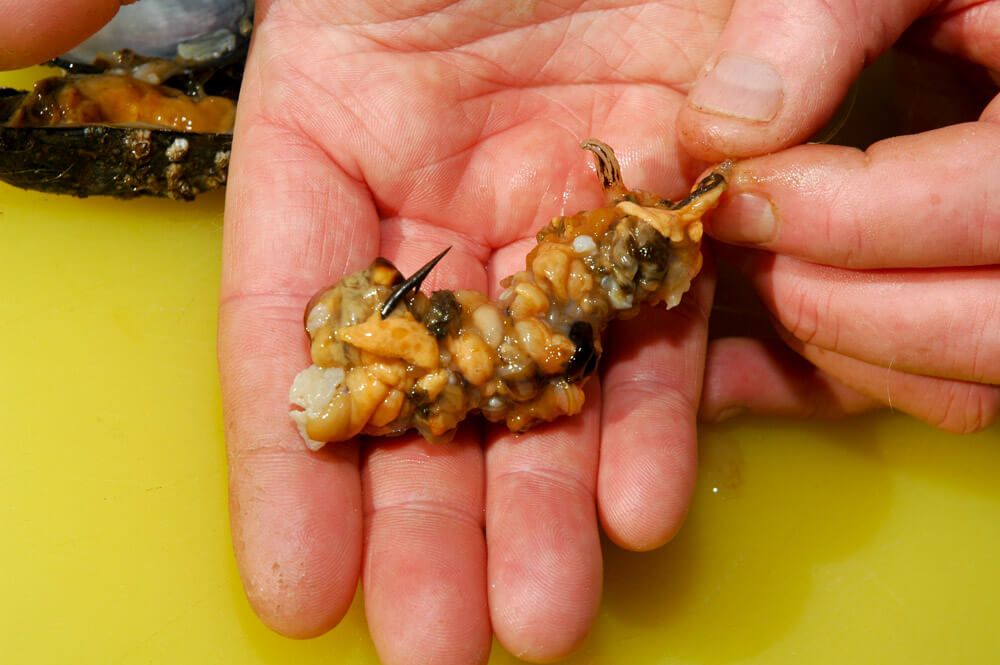
IS MUSSEL REALLY THAT GOOD AS A BAIT?
Yes! It's our most underused bait proving excellent over both rough ground and clean sand. It catches seasonal fish throughout the year, especially plaice, cod, coalfish and dabs. Spring plaice often have the tiny unopened seed mussels inside the gut cavities when caught.
BUYING TIPS
Mussel are cheap to buy from the Fishmonger and some supermarkets making it a quick, convenient way to get bait for sudden trips.
Check that all the mussels have closed shells. If any are open they are dead.
Once bought, as soon as possible, transfer them to a cool box for any long distance trips. Even a couple of hours in a plastic bag sweating inside a car boot will turn them.
IDENTIFICATION - COMMON MUSSEL
Instantly recognized by most people. The shell is round and sharp edged at the base, it has a hump back and slightly dished front where it attaches it'self to the rock face, and the top is more pointed and blunt.
The shell is black or slightly blue in adults, but can be light brown in the smaller seed mussel. It rarely exceeds 4" in length unlike the Horse mussel which although having a similar shape grows larger to 6".

HABITAT
A group living shellfish found clustered together along the mid and lower shore in rock pools, on rocks, pier supports and jetty legs, buoys, harbour walls and along breakwaters and groynes. Very common inside estuaries on the rocks and amongst weed beds.
The Horse mussel lives in large beds just beyond the low water line over clean sand/mud, on flat rocky beds and shallow reefs.

COLLECTION
The Common mussel holds itself onto the rocks and leg supports by attaching itself via a chemical thread it manufacturers through a gland in the foot. Grip the mussel across the back and just twist the hand around in a clockwise direction to release the mussels grip. Enough for a few hours fishing can be collected in just a few minutes.
Try to spread your areas of collection from one trip to the next. Don't keep taking mussels from the same pier supports and rocks otherwise you'll quickly deplete the stocks. Alternatively, choose only the single bigger mussels leaving the smaller ones to grow for future trips.
The only way to collect the larger Horse mussels is to wait until a storm tears the inshore seabed up and displaces the mussels which then litter the low tide line as they wash inshore. Again, you'll fill a bucket quickly.

TIDES
The Common mussel is accessible even on the smallest neap tides, though jetty supports, breakwaters and the rock pools may only uncover on the bigger tides. Occasionally, the Horse mussel beds may also expose but only on the largest spring tides.
STORAGE
If you want to keep mussels alive, it's easy and simple. Wash them thoroughly of all mud, etc, as this can quickly foul the water you keep them in. Place them in a large bucket full of fresh seawater and leave them covered over with a sack. Like this they will live for at least a week in cool weather, less in the summer. It pays to change the water, if possible, every couple of days and remove any that show signs of the shell opening as these are dying.
The day before a proposed trip, shell the mussels you are likely to need and place the mussels into a plastic jar or tub with a sealable lid and leave them in the fridge. Having stewed in their own juices for 24 hours they prove far more effective than even freshly shelled mussel. It also saves fishing time rather than shelling the mussels on the beach.
You can also freeze mussels very successfully. Shell them, place them either separately or in threes and fours into cling film or small sealable envelopes, and leave them in the fast freeze compartment of the freezer until frozen and store until needed. Prepared like this means that you can accurately gauge how many packets you'll need for a trip and being in threes and fours they are bait sized and also thaw quickly for instant baiting up.
Some Northeast anglers prefer their bait mussel to be high and long past freshness. They use an unusual method to get them just right. Having shelled the mussel they place them in muslin bags or even inside a pair of ladies tights, hang them on the washing line and leave them exposed to the air for a couple of days. This both toughens them and obviously increases their smell.
If you live very close to the sea or estuary, then providing you can find a suitable place where few people go, you can collect your mussels and place them in a anchored metal mesh box and leave them just below the low water line. Obviously, they'll live indefinitely like this and are quickly available to you.
HOW TO SHELL MUSSEL
Find an old metal teaspoon from the kitchen and slight sharpen the handle end and also the leading edge of the spoon it'self. Hold the closed mussel with the flat front side towards you. Push the end of the handle into the slightly open part of the shell where the threads are that hold the mussel to the rocks. Now twist this sideways and the shell will give and open halfway. Cut the white muscle and sinew free from the shells top and bottom and the shall now fully opens. Use the sharpened spoon to scoop out the complete mussel.

PRESENTATION
For short range fishing there is no need to use elastic to bind the mussel flesh to the hook. Put the hook point through the hard muscle end and the tongue, then pass the hook point through the mussel two or three times more to secure it. A single mussel is a good bait for plaice, flounder, coalfish, dabs, bass and small codling.
For longer range casts and also when after codling and cod over rough ground, use at least three or four mussels on a size 4/0 hook and then bind them securely with elastic thread aiming to create a sausage shaped bait with the hook point well clear.

IS MUSSEL REALLY THAT GOOD AS A BAIT?
Yes! It's our most underused bait proving excellent over both rough ground and clean sand. It catches seasonal fish throughout the year, especially plaice, cod, coalfish and dabs. Spring plaice often have the tiny unopened seed mussels inside the gut cavities when caught.
BUYING TIPS
Mussel are cheap to buy from the Fishmonger and some supermarkets making it a quick, convenient way to get bait for sudden trips.
Check that all the mussels have closed shells. If any are open they are dead.
Once bought, as soon as possible, transfer them to a cool box for any long distance trips. Even a couple of hours in a plastic bag sweating inside a car boot will turn them.

